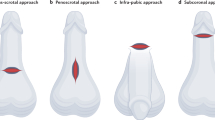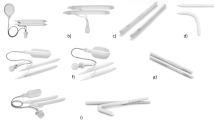Abstract
The Penuma® implant is a medical-grade silicone implant surgically inserted subcutaneously to provide cosmetic improvement of the penile aesthetic. The principal author was invited to provide an update on the usage of the Penuma® implant for penile aesthetics. He collected as yet unpublished data, which is undergoing synchronous submission to Urologic meetings and peer-reviewed publications by a variety of authors for this communication. The objective of this article is to provide updated information regarding the Penuma® aesthetic penile implant. A new scrotal method of implantation named “concealed” is emerging. Through physician comparison of various factors prior to and after the scrotal method intervention, early findings suggest this approach seems to have less visible scar, is quicker and is followed by less seroma formation. As the device is now surgically implanted by surgeons other than its inventor, new developments have appeared authenticating the original published paper in 2018. Patients were contacted via phone and were asked five questions regarding satisfaction with the responses recorded. This new multicenter study shows findings of high patient and partner satisfaction coupled with acceptable adverse outcomes similar to the single-surgeon study. A new penile rehabilitation program has been developed with the aim for the penis appearance to be restored to its pre-operative state if the Penuma® is removed. 12 patients who underwent penile implant removal were followed for 6 months while participating in the penile rehabilitation program. The discipline worked in patients who desired removal for dissatisfaction and is currently under evaluation in patients who require device removal for medical reasons, e.g., infection or suture-related issues. Through new developments, the acceptance of Penuma® in the prosthetic community seems to be further solidified.
This is a preview of subscription content, access via your institution
Access options
Subscribe to this journal
Receive 8 print issues and online access
$259.00 per year
only $32.38 per issue
Buy this article
- Purchase on Springer Link
- Instant access to full article PDF
Prices may be subject to local taxes which are calculated during checkout





Similar content being viewed by others

References
Yücel ÖB, Pazır Y, Kadıoğlu A. Penile prosthesis implantation in priapism. Sex Med Rev. 2018;6:310–8.
Elist JJ, Baniqued M, Hosseini A, Wilson SK. Correction of retractile penis with subcutaneous soft silicone penile implant. Int J Impot Res. 2020;32:317–22.
Elist J, Valenzuela R, Hillelsohn J, Feng T, Hosseini A. A single-surgeon retrospective and preliminary evaluation of the safety and effectiveness of the penuma silicone sleeve implant for elective cosmetic correction of the flaccid penis. J Sex Med. 2018;15:1216–23.
Veale D, Miles S, Read J, Troglia A, Carmona L, Fiorito C, et al. Penile dysmorphic disorder: development of a screening scale. Arch Sex Behav. 2015;44:2311–21.
Randhawa K, Shukla CJ. Non-invasive treatment in the management of Peyronie’s disease. Therapeutic Adv Urol. 2019;11:1756287218823671.
Cowper MG, Burkett CB, Le TV, Scherzer N, Hellstrom WJG. Penile stretching as a treatment for Peyronie’s disease: a review. Sex Med Rev. 2019;3:508–15.
Raheem AA, Garaffa G, Raheem TA, Dixon M, Kayes A, Christopher N, et al. The role of vacuum pump therapy to mechanically straighten the penis in Peyronie’s disease. BJU Int. 2010;106:1178–80.
Avant RA, Zieglmann M, Nehara A, Alom M, Kohler T, Trost L. Penile reaction therapy and vacuum erection devices in Peyronie’s disease. Sex Med Rev. 2019;2:338–48.
Sellers T, Dineen M, Salem EA, Wilson SK. Vacuum preparation, optimization of cylinder length and postoperative daily inflation reduces complaints of shortened penile length following implantation of inflatable penile prosthesis. Adv. Sexual Med. 2013;4:354–9.
Elist JJ, Levine L, Wang R, Wilson SK. Patient selection protocol for the Penuma® implant: suggested preoperative evaluation for aesthetic surgery of the penis. Int J Impot Res. 2020;32:149–52.
Author information
Authors and Affiliations
Contributions
SKW designed the study. Under the supervision of SKW, ALLP performed the phone interviews, gathered the necessary data and demographics, and conducted descriptive analytics. ALLP wrote the manuscript. Final revisions to the manuscript were made by SKW.
Corresponding author
Ethics declarations
Competing interests
SKW is a consultant for International Medical Devices. The other author declares no competing interest.
Additional information
Publisher’s note Springer Nature remains neutral with regard to jurisdictional claims in published maps and institutional affiliations.
Rights and permissions
About this article
Cite this article
Wilson, S.K., Picazo, AL.L. Update on the Penuma® an FDA-cleared penile implant for aesthetic enhancement of the flaccid penis. Int J Impot Res 34, 369–374 (2022). https://doi.org/10.1038/s41443-021-00510-y
Received:
Revised:
Accepted:
Published:
Issue Date:
DOI: https://doi.org/10.1038/s41443-021-00510-y
This article is cited by
-
Himplant® subcutaneous penile implant improves penile appearance and erectile dysfunction after radical prostatectomy: a case series
International Journal of Impotence Research (2024)
-
Use of Himplant® for correction of residual deformity following prior treatment of peyronie’s disease: a case series
International Journal of Impotence Research (2024)
-
Celebrating 50 years of penile implants
International Journal of Impotence Research (2023)
-
A response to recent penile enlargement industry media report
International Journal of Impotence Research (2023)
-
The effect of penis size on partner sexual satisfaction: a literature review
International Journal of Impotence Research (2023)


